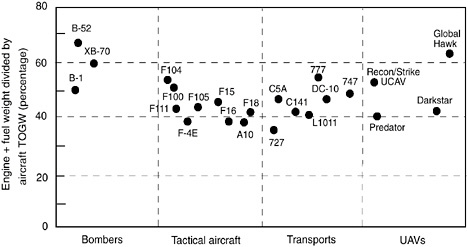UNIQUE OR ENABLING APPLIED RESEARCH
Low-Cost, Storable, Limited-Life Propulsion Systems
As currently envisioned, propulsion systems for UAVs can be divided into two broad categories: (1) vehicles operated routinely in peacetime (e.g., highaltitude reconnaissance UAVs), and (2) vehicles used only in wartime, for which most, or even all, training will be done by simulation. Engines for the first category of UAVs will have conventional operations and maintenance requirements. But the requirements of store-in-peace/use-in-war vehicles will be closer to those of cruise missiles. These vehicles will require engineering solutions for subsystems, such as fuel and lubrication systems, that must be capable of unattended storage for years and very fast start-up.
Traditionally, much of the profit for manufacturers of gas turbines has come from the sale of spare parts to replace parts consumed during military training. If vehicles are used only in wartime, manufacturers will have little or no opportunity to sell spare parts in peacetime (and thus no industry geared up to produce them), necessitating a different pricing structure for these engines. Therefore, although overall engine-related program costs might be reduced, costs would be shifted from the operations and maintenance budget to the procurement budget (i.e., the purchase price of engines would increase).
Engines are now nominally optimized for minimum life-cycle costs under the current market structure. A different life cycle can have different optimal conditions. For a given thrust, the optimum design for a 500-cycle engine life in a UCAV will be different than for a 4,000-cycle life (typical for a modern fighter) or for a 20,000-cycle life (for commercial aircraft). These differences will be apparent, for example, in the lower requirements for material creep life, maintenance, and survivability. The lower requirements might also be reflected in the selection of materials (for lower cost and weight), lighter weight structures (especially rotating parts), and less emphasis on aging and maintainability characteristics (e.g., thinner airfoils, more welds, and fewer bolted joints).
Technology for storable engines already exists for cruise missiles and smaller engine sizes (700-lb. thrust and below) with very limited lives (tens of hours). However, this technology has not been used for larger engines (more than 1,000-lb. thrust) with longer lives (500 hours), which are contemplated for UCAVs.
Propulsion for High-Speed, Highly-Maneuverable UAVs
Current engine designs accommodate steady inertial loads compatible with human life (nominally up to 9g’s), as well as a capability to withstand additional impulsive loads from hard landings. (A typical military design requirement is illustrated in Figure 5-5.) If the maneuver envelope is increased for UCAVs, new











